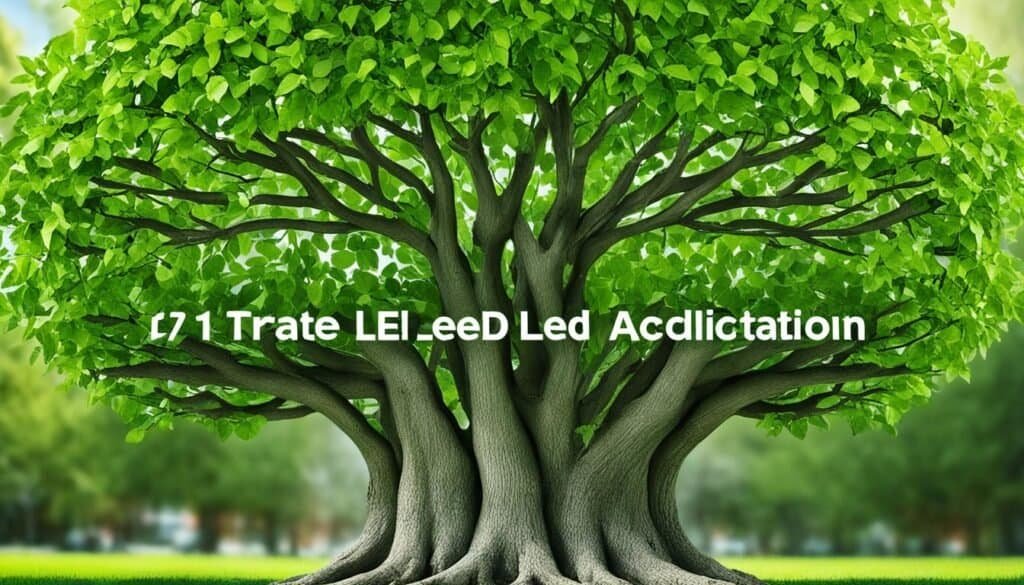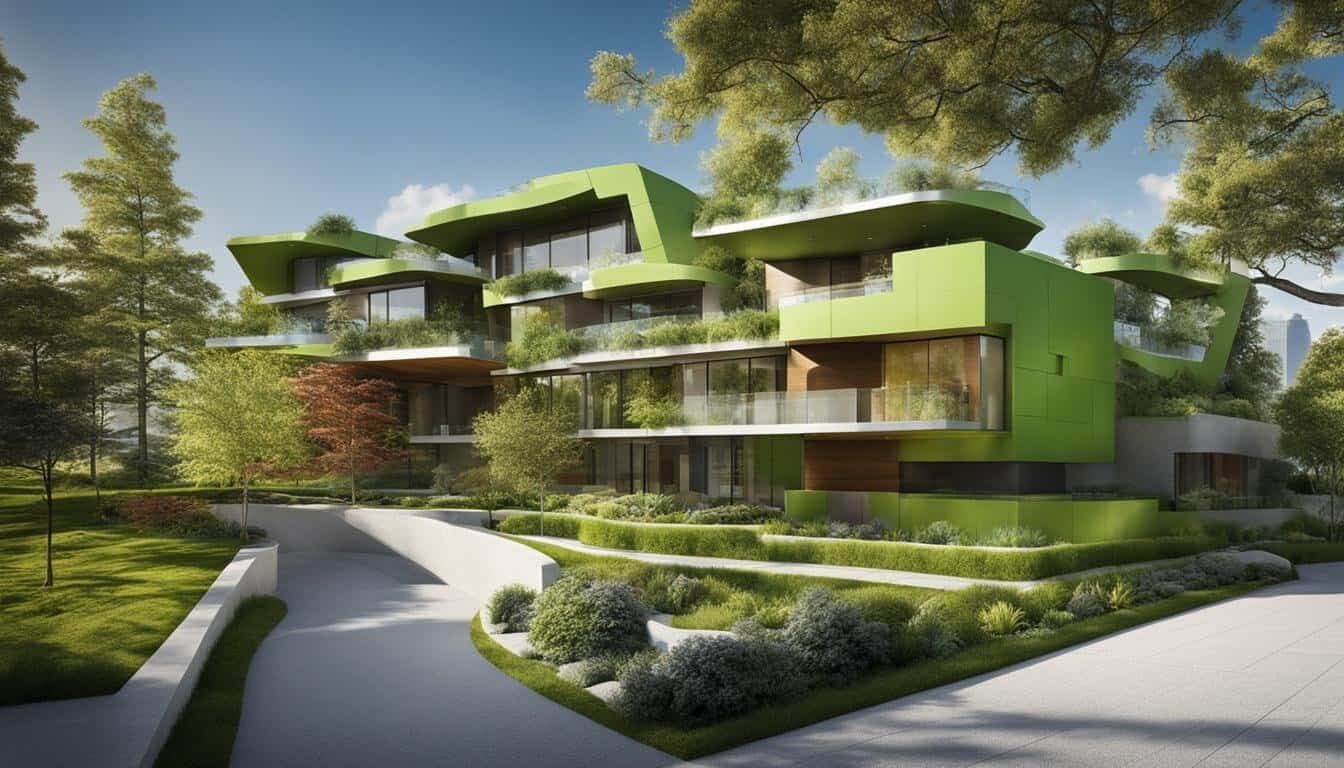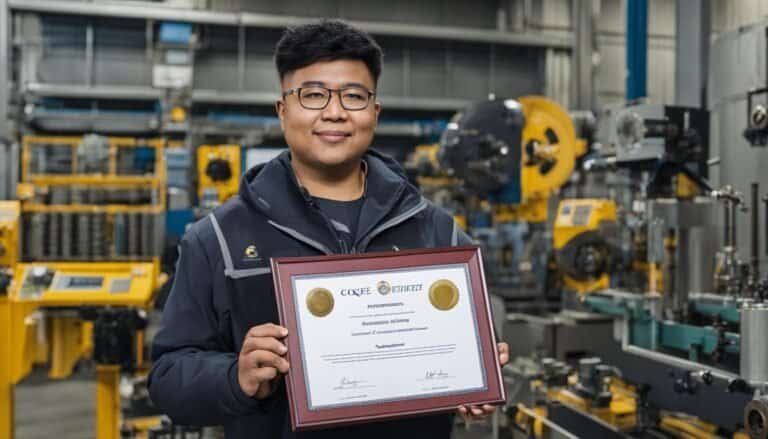LEED Professional Credentials
Did you know that over 203,000 professionals worldwide have earned LEED Professional Credentials?
LEED credentials, offered by the U.S. Green Building Council (USGBC), signify proficiency in sustainable design, construction, and operations standards. This globally recognized certification is a testament to an individual’s knowledge, experience, and credibility in the green building industry.
Whether you’re new to sustainable building or a seasoned professional, earning a LEED credential can open doors to exciting opportunities and contribute to the advancement of sustainable development. Let’s explore the different types of LEED credentials, their benefits, and how you can obtain and maintain them.
Key Takeaways:
- LEED Professional Credentials are certifications that demonstrate proficiency in green building principles and practices.
- Over 203,000 professionals worldwide have earned LEED credentials.
- The two main types of LEED credentials are LEED Green Associate and LEED AP with specialty.
- LEED Green Associate is ideal for those new to green building, while LEED AP with specialty signifies expertise in a specific LEED rating system.
- Earning and maintaining a LEED credential requires continuing education and staying up-to-date with the latest sustainable building practices.
Showcase Your Knowledge with LEED Green Associate
The LEED Green Associate credential is a foundational professional credential that demonstrates core competency in green building principles. It measures general knowledge of green building practices and how to support others working on LEED projects. Studying for the exam provides fundamental knowledge of green building concepts and helps validate sustainability knowledge.
By obtaining the LEED Green Associate credential, professionals showcase their commitment to green building principles and gain a solid understanding of the LEED projects and sustainable practices. This prestigious credential carries significant weight in the industry, proving expertise in the field of sustainable development.
The LEED Green Associate exam prep covers a wide range of topics, including sustainable sites, water efficiency, energy and atmosphere, materials and resources, indoor environmental quality, and innovation in design. It is designed to equip professionals with the knowledge and skills needed to contribute effectively to green building projects.
The LEED Green Associate credential is the perfect starting point for those looking to establish a strong foundation in green building principles. It is a testament to one’s commitment to sustainability and ability to support LEED projects.
Preparing for the LEED Green Associate exam involves familiarizing oneself with the green building principles outlined in the LEED Rating System. Candidates should study concepts such as energy efficiency, water conservation, materials and resources, and indoor environmental quality. Several resources, including study guides, practice exams, and online courses, are available to aid in the exam prep process.
Benefits of Obtaining the LEED Green Associate Credential
- Enhances credibility and recognition in the sustainable building industry
- Increases career opportunities and employability
- Provides a comprehensive understanding of green building principles
- Establishes a foundation for pursuing further LEED specialty credentials
- Demonstrates commitment to sustainability and sustainable practices
The LEED Green Associate credential is an essential step for professionals seeking to make a positive impact in the green building industry. It not only validates their knowledge and understanding of green building principles, but also opens doors to a variety of exciting sustainable career opportunities.
Expertise in Green Building with LEED AP with Specialty
For individuals actively involved in green building and LEED projects, the LEED AP with specialty credential is the ideal recognition of expertise. Building upon the LEED Green Associate credential, this advanced certification signifies comprehensive knowledge of green building, a specific LEED rating system, and the certification process.
To earn the LEED AP with specialty credential, candidates must first pass the LEED Green Associate exam, demonstrating a foundational understanding of green building principles. This sets the stage for in-depth learning and specialization in a specific LEED rating system that aligns with their professional focus and interests.
With the LEED AP with specialty credential, professionals gain a deeper understanding of sustainable design, construction, and operations within their chosen rating system. This enables them to provide valuable expertise in implementing green building strategies, optimizing resource efficiency, and ensuring high-performance in green building projects.
LEED APs with specialty play a critical role in leading and guiding green building initiatives, contributing to the overall sustainability of the built environment. Whether it’s designing energy-efficient buildings, implementing renewable energy technologies, or creating healthy and comfortable spaces, these professionals are at the forefront of green building innovation.
By combining their LEED AP with specialty credential with practical experience and a thorough understanding of the certification process, these experts are capable of guiding projects from conception to successful LEED certification.
Benefits of the LEED AP with Specialty Credential
Earning the LEED AP with specialty credential offers several advantages:
- Enhanced expertise in green building within a specific LEED rating system
- Recognition of specialized knowledge and skills in sustainable design and construction
- Ability to lead and manage LEED projects with confidence and authority
- Increased professional credibility and marketability
- Access to a network of industry professionals and resources through the US Green Building Council (USGBC)
To illustrate the various specialties available within the LEED AP program, below is a table highlighting some of the popular specialties:
| LEED AP Specialty | Description |
|---|---|
| Building Design and Construction (BD+C) | For professionals working on new construction and major renovation projects |
| Operations and Maintenance (O+M) | For professionals focused on existing buildings and ongoing sustainability |
| Interior Design and Construction (ID+C) | For professionals designing and remodeling interior spaces |
| Neighborhood Development (ND) | For professionals engaged in sustainable urban planning and development |
The LEED AP with specialty credential opens doors to exciting career opportunities and allows professionals to make a significant impact on the adoption of sustainable practices in the built environment. With this credential, individuals can confidently lead green building projects, drive innovation, and contribute to a more sustainable future.
Options for LEED Credential Exams
When it comes to taking the LEED credential exam, individuals have several options to choose from. Whether you prefer a traditional in-person experience or the convenience of taking the exam remotely, there is a solution that suits your needs. Let’s explore the different options available:
Prometric Testing Center
The Prometric Testing Center offers a secure and professional environment for taking the LEED credential exam. With locations worldwide, you can find a testing center near you. The Prometric Testing Center ensures a comfortable and controlled setting, providing all the necessary resources for a successful exam experience.
Remote Proctored Online Exam
If you prefer the flexibility of taking the exam from the comfort of your own home or office, the remote proctored online exam option is perfect for you. This option allows you to complete the exam remotely while still maintaining the integrity and security of the testing process. All you need is a reliable internet connection and a quiet environment to take the exam.
Alternative Exam Delivery Options
In addition to the Prometric Testing Center and the remote proctored online exam, there are alternative exam delivery options available. These options are particularly beneficial for groups or organizations that wish to take the LEED credential exam together. By coordinating with the exam provider, groups can arrange for a customized exam experience that suits their specific needs.
Whether you prefer the traditional testing center setting, the convenience of a remote exam, or the flexibility of alternative delivery options for groups, there is a solution for everyone. Choose the option that best fits your preferences and schedule, and begin your journey towards earning your LEED credential.
Maintaining and Renewing Your Credential
To maintain and renew your LEED credential, it is important to stay current and continue learning through continuing education (CE) hours. These CE hours ensure that you stay up-to-date with the latest developments in sustainable design and construction, allowing you to maintain your expertise in the field.
The number of required CE hours varies depending on your LEED credential. LEED Green Associates must earn and report 15 CE hours, while LEED APs with specialty must earn and report 30 CE hours within a 2-year cycle. These CE hours can be earned through a variety of LEED-specific activities, including:
- Completing educational courses on green building principles
- Gaining hands-on experience in LEED projects
- Attending conferences and seminars focused on sustainable design
- Participating in webinars or online training programs
Earning and reporting your CE hours demonstrates your commitment to professional development and ensures that you are staying current with the latest advancements in the green building industry.
By renewing your credentials, you not only maintain your professional standing but also strengthen your credibility as a sustainable design expert. It shows your dedication to ongoing learning and reinforces your expertise in the field.
Renewal Instructions
To renew your LEED credential, follow these simple steps:
- Ensure that you have completed the required number of CE hours within your 2-year cycle.
- Report your earned CE hours through the LEED Credential Maintenance Program.
- Pay the credential maintenance fee to complete the renewal process.
By following these steps, you can maintain your LEED credential and continue contributing to the sustainable development of our built environment.
Benefits of Renewing Your Credentials
“Renewing your LEED credentials ensures that you stay current with the latest advancements in sustainable design and construction, allowing you to provide the highest level of expertise to your clients and colleagues.”
Renewing your credentials offers several benefits:
| Benefits of Renewing Your LEED Credentials |
|---|
| 1. Stay up-to-date with the latest trends and innovations in sustainable design |
| 2. Enhance your credibility as a LEED professional |
| 3. Access exclusive networking opportunities with like-minded professionals |
| 4. Expand your knowledge and expertise in LEED-specific practices |
Renewing your LEED credentials not only ensures your professional growth but also reinforces your commitment to creating a greener and more sustainable future.
LEED Fellows and Certificates
Within the LEED professional community, there are esteemed individuals known as LEED Fellows. These LEED Fellows are LEED APs who have showcased exceptional expertise and leadership in the green building industry. To become a LEED Fellow, professionals must undergo an extensive portfolio review and demonstrate a minimum of 10 years of experience in the field. This designation signifies their technical knowledge, commitment to sustainability, and outstanding contributions to the green building industry.
In addition to achieving LEED professional credentials, individuals can further enhance their expertise by earning certificates in specific areas of the green building industry. These certificates provide recognition and validation of specialized knowledge and skills. Let’s explore a couple of these certificates:
LEED Green Rater
The LEED Green Rater certificate is designed for professionals who specialize in rating the performance of residential projects. Green Raters play a crucial role in ensuring that homes and multi-family buildings meet the rigorous sustainability criteria set by the LEED rating system. Their technical expertise and attention to detail contribute to the overall sustainability and energy efficiency of residential structures.
Green Classroom Professional
The Green Classroom Professional certificate is targeted towards individuals who are passionate about creating sustainable learning environments. These professionals possess the knowledge and skills to design and implement green initiatives in schools, fostering healthier spaces for students and staff. Green Classroom Professionals prioritize energy efficiency, waste reduction, and environmentally friendly practices to optimize the sustainability of educational facilities.
By earning these certificates, professionals in the green building industry can expand their skill sets, showcase their specialized knowledge, and contribute to the growth and development of sustainable practices in their respective fields.
LEED Certification Levels for Buildings
LEED building certifications are divided into four levels based on points earned in six key categories. These levels serve as a benchmark to assess the sustainability and environmental performance of a building. The certification levels are as follows:
- Certified: Buildings that earn 40-49 points are awarded LEED Certified status. This level demonstrates a commitment to sustainable practices and serves as a stepping stone towards higher certification levels.
- Silver: Silver certification is achieved by earning 50-59 points. Buildings at this level demonstrate a higher level of sustainability and efficiency, incorporating advanced green building strategies.
- Gold: Gold certification signifies excellence in sustainable design and construction, with buildings earning 60-79 points. These buildings go above and beyond standard green building practices, showcasing significant environmental performance.
- Platinum: The highest level of LEED certification, Platinum, is awarded to buildings that earn 80 or more points. These buildings demonstrate exceptional leadership in sustainability, incorporating innovative strategies and technologies to achieve the highest level of environmental performance.
To be eligible for LEED certification, buildings must also satisfy prerequisites, which include minimum requirements for energy efficiency, water efficiency, and other sustainable design principles. These prerequisites ensure that certified buildings meet basic sustainability standards.
Earning a LEED certification is a significant achievement for building owners and demonstrates their commitment to sustainable construction practices. It also provides a clear indication to occupants and the community that the building is designed, constructed, and operated with a focus on environmental sustainability.
.
Two Tiers of Professional Accreditation
Becoming a LEED accredited professional is a testament to one’s expertise in sustainable design and construction. It involves two tiers of professional accreditation: the LEED Green Associate and the LEED AP with Specialty.
Earning the LEED Green Associate Credential
The first step in the LEED accreditation journey is to earn the LEED Green Associate credential. This credential is obtained by passing a rigorous 100-question exam that assesses knowledge of green building fundamentals and principles.
LEED Green Associates demonstrate a solid understanding of integrated project delivery, which is crucial for effective collaboration within a LEED project team. With this credential, individuals can contribute to sustainable building projects and make a positive impact on the environment.
The Value of LEED AP with Specialty
Once LEED Green Associates have established a strong foundation in green building, they can pursue the LEED AP with Specialty credential. This credential signifies expertise in a specific LEED rating system and demonstrates a deeper understanding of sustainable building practices.
LEED APs with Specialty are valuable contributors to a LEED project team, bringing specialized knowledge and insights. They play a critical role in guiding projects towards LEED certification and ensuring the integration of sustainable strategies.
“LEED accreditation validates professionals’ knowledge of integrated project delivery and makes them valuable contributors to the LEED project team.” – John Green, LEED AP
By achieving both the LEED Green Associate and LEED AP with Specialty credentials, professionals can establish themselves as experts in the field of green building. They gain recognition for their commitment to sustainability and become trusted advisors in the industry.

The image above showcases the LEED AP certification, a symbol of excellence in sustainable design and construction.
Conclusion
Obtaining LEED Professional Credentials is the key to unlocking a world of opportunities for individuals in the green building industry. These credentials not only showcase an individual’s comprehensive green building expertise, but also serve as a testament to their commitment to creating a sustainable career. With a LEED certification in hand, professionals can contribute to the development of sustainable communities and advance their careers in this rapidly growing field.
By earning a globally recognized LEED credential, professionals establish themselves as knowledgeable experts who possess the necessary skills to design, construct, and operate sustainable buildings. These credentials validate the individual’s green building expertise and provide credibility in the marketplace.
Furthermore, LEED Professional Credentials open doors to a wide range of opportunities. Professionals with these credentials are sought after by employers who prioritize sustainability and are looking to hire individuals with proven skills and commitment to green building. Additionally, obtaining LEED Professional Credentials allows individuals to become part of a global network of professionals who are passionate about creating a more sustainable future.
FAQ
What are LEED Professional Credentials?
LEED Professional Credentials signify proficiency in sustainable design, construction, and operations standards.
How many professionals have earned LEED credentials worldwide?
Over 203,000 professionals worldwide have earned LEED credentials.
What is the LEED Green Associate credential?
The LEED Green Associate credential is a foundational professional credential that demonstrates core competency in green building principles.
What does the LEED AP with specialty credential signify?
The LEED AP with specialty credential signifies expertise in green building and a specific LEED rating system.
Where can I take the LEED credential exam?
Individuals have the option to take the LEED credential exam at a Prometric Testing Center or as a remote proctored online exam.
How do I maintain and renew a LEED credential?
To maintain and renew a LEED credential, professionals must earn and report continuing education (CE) hours within a 2-year cycle.
What are LEED Fellows?
LEED Fellows are LEED APs who have demonstrated excellence in green building and sustainability.
What are the certification levels for LEED buildings?
LEED building certifications are divided into four levels based on points earned in six key categories: Certified, Silver, Gold, and Platinum.
How can I become LEED accredited?
Becoming LEED accredited starts with learning green building fundamentals and earning the LEED Green Associate credential.







